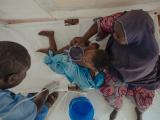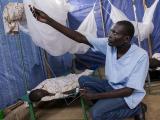May 3, 2012
Serotype change seen in recent Haiti cholera samples
The US Centers for Disease Control and Prevention (CDC) said today it has confirmed that two cholera samples collected in Haiti in March are a different serotype than the one that caused the massive outbreak, a finding that raises worries that people already infected may be vulnerable to the new strain. Detailing its findings in Morbidity and Mortality Weekly Report (MMWR), the CDC said the isolates were collected in Artibonite department and were first characterized at Haiti's National Public Health Laboratory and involve the Inaba serotype of Vibrio cholerae, as opposed to the Ogawa serotype outbreak strain. Molecular analysis showed that the two samples are indistinguishable from the currently circulating Ogawa strain, which the CDC said suggests serotype switching occurred, a common feature of cholera epidemics that is frequently driven by population immunity. It added that cross-protective immunity between the serotypes is incomplete, and if the Inaba serotype becomes established, people who had earlier Ogawa infections might be more vulnerable to reinfection with the Inaba serotype. The two subtypes don't vary in their clinical profiles, and prequalified vaccines protect against both.
May 4 MMWR report
Report details imported rabies infection in Army soldier
The August 2011 rabies death of a US Army soldier who was bitten by a feral dog while serving in Afghanistan underscores the risk to travelers and the need for prompt medical care and postexposure, the CDC said today. Officials from the CDC and their partners described the man's infection in MMWR. He started having symptoms in the middle of August during travel from a base in Germany to his next assignment in New York. He sought care three times for symptoms such as neck pain, then was hospitalized at Fort Drum a few days later when his symptoms worsened. When the patient revealed he had been bitten by a dog in January 2011 while in Afghanistan, the medical team notified state and federal officials about a suspected rabies infection and transferred the patient to another hospital where isolation precautions were instituted and detailed lab tests were done, which revealed rabies exposure with a variant associated with dogs in Afghanistan. Health officials identified 190 people the man had contact with while sick, and 13 received postexposure prophylaxis (PEP), along with 7 members of his previous Army unit. The man's condition worsened, despite receiving an experimental treatment protocol of ketamine, fentanyl, and midazolam, and he died on Aug 31. An investigation revealed the man had told family member that he received wound cleansing and injections after the bite, but no treatment documentation was found, and a banked serum specimen from May 2011 revealed no evidence that the man had received PEP.
May 4 MMWR report
Rise in hepatitis C deaths in baby boomers worries feds
The number of deaths from hepatitis C in baby boomers is increasing so fast that federal officials are planning a nationwide effort to encourage widespread testing, the LA Times reported yesterday. About three fourths of the approximately 3.2 million Americans who have chronic hepatitis C and of those who die from it are baby boomers, the story said. Deaths from the disease nearly doubled from 1999 to 2007, to more than 15,000, according to data from the Centers for Disease Control and Prevention (CDC). "We have sort of a perfect storm of an age wave of people who are moving through time who are progressively becoming sicker from an infection that was acquired several decades ago," said CDC hepatitis expert John Ward, MD. "We think we are at a very critical juncture." The disease, which is often contracted via blood, often remains hidden for decades and can slowly destroy liver cells, the story said.
May 2 LA Times story
















